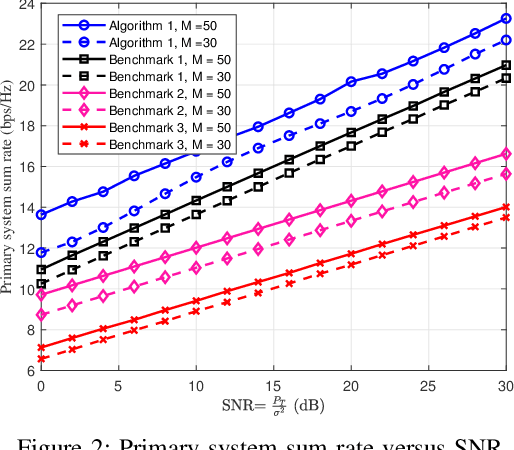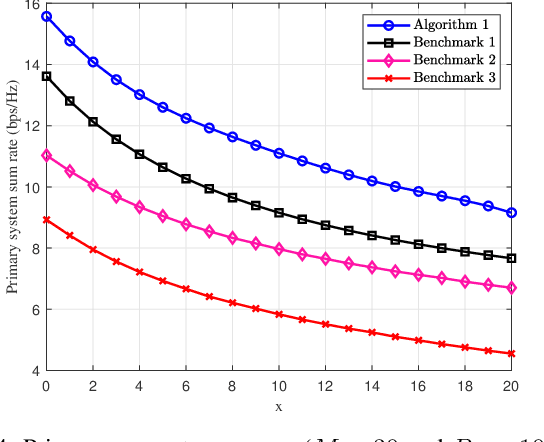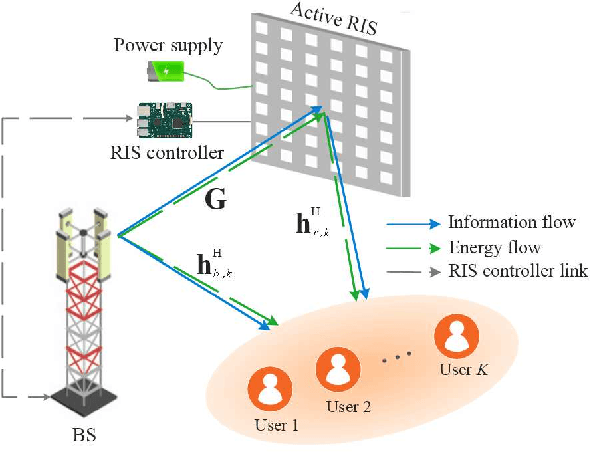Shayan Zargari
Low-Complexity Multi-Target Detection in ELAA ISAC
Jan 29, 2025



Abstract:Multi-target detection and communication with extremely large-scale antenna arrays (ELAAs) operating at high frequencies necessitate generating multiple beams. However, conventional algorithms are slow and computationally intensive. For instance, they can simulate a \num{200}-antenna system over two weeks, and the time complexity grows exponentially with the number of antennas. Thus, this letter explores an ultra-low-complex solution for a multi-user, multi-target integrated sensing and communication (ISAC) system equipped with an ELAA base station (BS). It maximizes the communication sum rate while meeting sensing beampattern gain targets and transmit power constraints. As this problem is non-convex, a Riemannian stochastic gradient descent-based augmented Lagrangian manifold optimization (SGALM) algorithm is developed, which searches on a manifold to ensure constraint compliance. The algorithm achieves ultra-low complexity and superior runtime performance compared to conventional algorithms. For example, it is \num{56} times faster than the standard benchmark for \num{257} BS antennas.
Downlink Beamforming for Cell-Free ISAC: A Fast Complex Oblique Manifold Approach
Sep 10, 2024Abstract:Cell-free integrated sensing and communication (CF-ISAC) systems are just emerging as an interesting technique for future communications. Such a system comprises several multiple-antenna access points (APs), serving multiple single-antenna communication users and sensing targets. However, efficient beamforming designs that achieve high precision and robust performance in densely populated networks are lacking. This paper proposes a new beamforming algorithm by exploiting the inherent Riemannian manifold structure. The aim is to maximize the communication sum rate while satisfying sensing beampattern gains and per AP transmit power constraints. To address this constrained optimization problem, a highly efficient augmented Lagrangian model-based iterative manifold optimization for CF-ISAC (ALMCI) algorithm is developed. This algorithm exploits the geometry of the proposed problem and uses a complex oblique manifold. Conventional convex-concave procedure (CCPA) and multidimensional complex quadratic transform (MCQT)-CSA algorithms are also developed as comparative benchmarks. The ALMCI algorithm significantly outperforms both of these. For example, with 16 APs having 12 antennas and 30 dBm transmit power each, our proposed ALMCI algorithm yields 22.7% and 6.7% sum rate gains over the CCPA and MCQT-CSA algorithms, respectively. In addition to improvement in communication capacity, the ALMCI algorithm achieves superior beamforming gains and reduced complexity.
A Riemannian Manifold Approach to Constrained Resource Allocation in ISAC
Apr 08, 2024Abstract:This paper introduces a new resource allocation framework for integrated sensing and communication (ISAC) systems, which are expected to be fundamental aspects of sixth-generation networks. In particular, we develop an augmented Lagrangian manifold optimization (ALMO) framework designed to maximize communication sum rate while satisfying sensing beampattern gain targets and base station (BS) transmit power limits. ALMO applies the principles of Riemannian manifold optimization (MO) to navigate the complex, non-convex landscape of the resource allocation problem. It efficiently leverages the augmented Lagrangian method to ensure adherence to constraints. We present comprehensive numerical results to validate our framework, which illustrates the ALMO method's superior capability to enhance the dual functionalities of communication and sensing in ISAC systems. For instance, with 12 antennas and 30 dBm BS transmit power, our proposed ALMO algorithm delivers a 10.1% sum rate gain over a benchmark optimization-based algorithm. This work demonstrates significant improvements in system performance and contributes a new algorithmic perspective to ISAC resource management.
Sensing and Backscatter Communication Integration: Realizing Efficiency in Wireless Systems for IoT
Dec 11, 2023Abstract:In an era driven by the Internet of Things (IoT) and rapid wireless communication advances, the synergy between sensing and backscatter communication (BackCom) has emerged as a frontier of research. This paper delves deep into the integration of sensing technologies with BackCom, a burgeoning field with significant implications for energy-efficient wireless systems. By tracing the historical developments and principles of BackCom, we establish the foundational understanding crucial for integrating advanced sensing methodologies. Our study adopts a mixed-method approach, combining quantitative analyses of system performances with qualitative assessments of various integration techniques. Furthermore, these integrated systems showcase enhanced adaptability in dynamic environments, a pivotal attribute for future IoT applications. These findings hold profound implications for industries focusing on smart technologies, as they underscore the potential for achieving both sustainable and efficient communication. Our research distinguishes itself by not only highlighting the benefits but also addressing the challenges faced in this integration, providing a comprehensive overview of the topic.
Signal Detection in Ambient Backscatter Systems: Fundamentals, Methods, and Trends
Dec 06, 2023Abstract:Internet-of-Things (IoT) is rapidly growing in wireless technology, aiming to connect vast numbers of devices to gather and distribute vital information. Despite individual devices having low energy consumption, the cumulative demand results in significant energy usage. Consequently, the concept of ultra-low-power tags gains appeal. Such tags communicate by reflecting rather than generating the radio frequency (RF) signals by themselves. Thus, these backscatter tags can be low-cost and battery-free. The RF signals can be ambient sources such as wireless-fidelity (Wi-Fi), cellular, or television (TV) signals, or the system can generate them externally. Backscatter channel characteristics are different from conventional point-to-point or cooperative relay channels. These systems are also affected by a strong interference link between the RF source and the tag besides the direct and backscattering links, making signal detection challenging. This paper provides an overview of the fundamentals, challenges, and ongoing research in signal detection for AmBC networks. It delves into various detection methods, discussing their advantages and drawbacks. The paper's emphasis on signal detection sets it apart and positions it as a valuable resource for IoT and wireless communication professionals and researchers.
IRS-Enabled Backscattering in a Downlink Non-Orthogonal Multiple Access System
Sep 02, 2022



Abstract:Intelligent reflecting surface (IRS)-enabled backscatter communications can be enabled by an access point (AP) that splits its transmit signal into modulated and unmodulated parts. This letter integrates non-orthogonal multiple access (NOMA) with this method to create a two-user primary system and a secondary system of IRS data. Considering the decoding order, we maximize the rate of the strongest primary user by jointly optimizing the IRS phase shifts, power splitting (PS) factor at the AP, and NOMA power coefficients while guaranteeing the quality of service (QoS) for both weak user and IRS data in the primary and secondary systems, respectively. The resulting optimization problem is non-convex. Thus, we split it into three parts and develop an alternating optimization (AO) algorithm. The advantage is that we derive closed-form solutions for the PS factor and NOMA power coefficients in the first two parts. In the third part, we optimize the phase shifts by exploiting semi-definite relaxation (SDR) and penalty techniques to handle the unit-modulus constraints. This algorithm achieves substantial gains (e.g., 40--68%) compared to relevant baseline schemes.
Multiuser MISO PS-SWIPT Systems: Active or Passive RIS?
Jun 28, 2022


Abstract:Reconfigurable intelligent surface (RIS)-based communication networks promise to improve channel capacity and energy efficiency. However, the promised capacity gains could be negligible for passive RISs because of the double pathloss effect. Active RISs can overcome this issue because they have reflector elements with a low-cost amplifier. This letter studies the active RIS-aided simultaneous wireless information and power transfer (SWIPT) in a multiuser system. The users exploit power splitting (PS) to decode information and harvest energy simultaneously based on a realistic piecewise nonlinear energy harvesting model. The goal is to minimize the base station (BS) transmit power by optimizing its beamformers, PS ratios, and RIS phase shifts/amplification factors. The simulation results show significant improvements (e.g., 19% and 28%) with the maximum reflect power of 10 mW and 15 mW, respectively, compared to the passive RIS without higher computational complexity cost. We also show the robustness of the proposed algorithm against imperfect channel state information.
Resource Management for Transmit Power Minimization in UAV-Assisted RIS HetNets Supported by Dual Connectivity
Jun 24, 2021



Abstract:This paper proposes a novel approach to improve the performance of a heterogeneous network (HetNet) supported by dual connectivity (DC) by adopting multiple unmanned aerial vehicles (UAVs) as passive relays that carry reconfigurable intelligent surfaces (RISs). More specifically, RISs are deployed under the UAVs termed as UAVs-RISs that operate over the micro-wave ($\mu$W) channel in the sky to sustain a strong line-of-sight (LoS) connection with the ground users. The macro-cell operates over the $\mu$W channel based on orthogonal multiple access (OMA), while small base stations (SBSs) operate over the millimeter-wave (mmW) channel based on non-orthogonal multiple access (NOMA). We study the problem of total transmit power minimization by jointly optimizing the trajectory/velocity of each UAV, RISs' phase shifts, subcarrier allocations, and active beamformers at each BS. The underlying problem is highly non-convex and the global optimal solution is intractable. To handle it, we decompose the original problem into two subproblems, i.e., a subproblem which deals with the UAVs' trajectories/velocities, RISs' phase shifts, and subcarrier allocations for $\mu$W; and a subproblem for active beamforming design and subcarrier allocation for mmW. In particular, we solve the first subproblem via the dueling deep Q-Network (DQN) learning approach by developing a distributed algorithm which leads to a better policy evaluation. Then, we solve the active beamforming design and subcarrier allocation for the mmW via the successive convex approximation (SCA) method. Simulation results exhibit the effectiveness of the proposed resource allocation scheme compared to other baseline schemes. In particular, it is revealed that by deploying UAVs-RISs, the transmit power can be reduced by 6 dBm while maintaining similar guaranteed QoS.
Max-Min Fair Energy-Efficient Beamforming Design for Intelligent Reflecting Surface-Aided SWIPT Systems with Non-linear Energy Harvesting Model
Mar 22, 2021



Abstract:This paper considers an intelligent reflecting sur-face (IRS)-aided simultaneous wireless information and power transfer (SWIPT) network, where multiple users decode data and harvest energy from the transmitted signal of a transmit-ter. The proposed design framework exploits the cost-effective IRS to establish favorable communication environment to improve the fair energy efficient. In particular, we study the max-min energy efficiency (EE) of the system by jointly designing the transmit information and energy beamforming at the base station (BS), phase shifts at the IRS, as well as the power splitting (PS) ratio at all users subject to the minimum rate, minimum harvested energy, and transmit power constraints. The formulated problem is non-convex and thus challenging to be solved. We propose two algorithms namely penalty-based and inner approximation (IA)-based to handle the non-convexity of the optimization problem. As such, we divide the original problem into two sub-problems and apply the alternating optimization (AO) algorithm for both proposed algorithms to handle it iteratively. In particular, in the penalty-based algorithm for the first sub-problem, the semi-definite relaxation (SDR) technique, difference of convex functions (DC) programming, majorization-minimization (MM) approach, and fractional programming theory are exploited to transform the non-convex optimization problem into a convex form that can be addressed efficiently. For the second sub-problem, a penalty-based approach is proposed to handle the optimization on the phase shifts introduced by the IRS with the proposed algorithms. For the IA-based method, we optimize jointly beamforming vectors and phase shifts while the PS ratio is solved optimally in the first sub-problem...
 Add to Chrome
Add to Chrome Add to Firefox
Add to Firefox Add to Edge
Add to Edge